|
|
keldorn

  
  
Promising
Known Hero
that casts green flames
|
 posted August 25, 2011 04:00 PM
posted August 25, 2011 04:00 PM |
|
Edited by keldorn at 16:09, 25 Aug 2011.
|
Allright, a positional lecture is on its way  In the meantime, of course, I've some puzzles for you. Please use HCM. In the meantime, of course, I've some puzzles for you. Please use HCM.
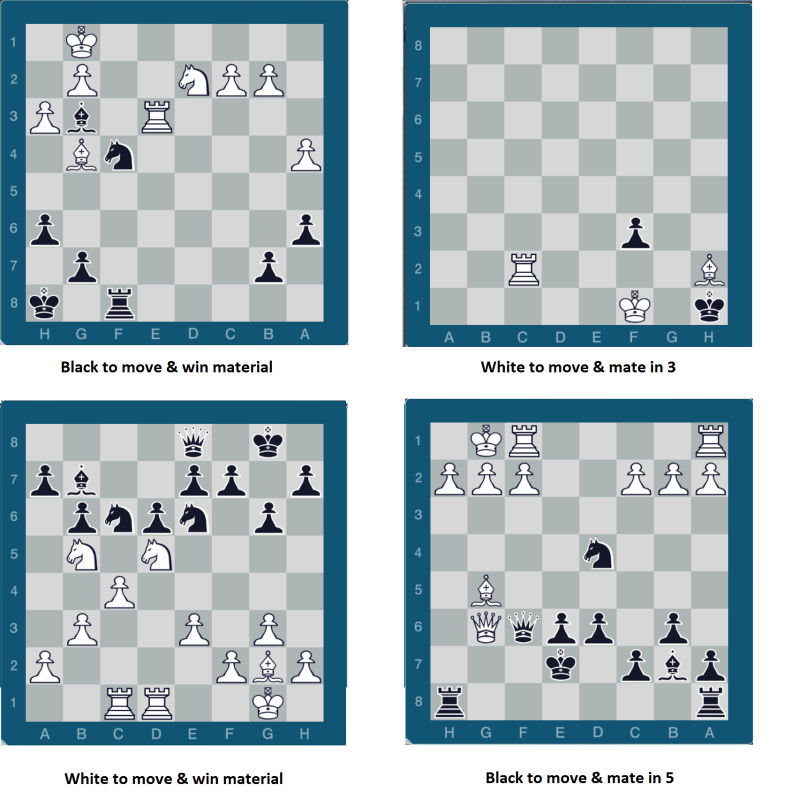
P.S. Doom, what about you? Have you got something to share? Don't be shy  
____________
|
|
keldorn

  
  
Promising
Known Hero
that casts green flames
|
 posted August 29, 2011 05:46 PM
posted August 29, 2011 05:46 PM |
 bonus applied by Corribus on 30 Aug 2011. bonus applied by Corribus on 30 Aug 2011. |
Edited by keldorn at 21:24, 29 Aug 2011.
|
So this would be an introduction to positional play in chess - one of the most difficult parts of the game to learn. It comes into consideration if there's no immediate tactic on the board and you need to come up with a plan to solidify your position. But what do we call a 'solid position'?
Well, there are a lot of concepts of positional play, but before taking a closer look at them, let's talk about the positional play itself. Chess grandmasters have built up a tremendous arsenal of positional ideas, one of them being the entire opening theory (see later). To reach a better strategical position, you first need to know the basic motifs of it. If you can answer all of the questions below, than you're ready to put them into practice.
1) Define the following concepts in reference to pawns: a pawn island, a backward pawn, isolated pawns, connected pawns, a passed pawn, an advanced pawn, an overextended pawn, an outpost, a hole, doubled pawns, blocked pawns, open/closed position
2) How to exploit an outpost? What is it good for?
3) If your opponent expands pawns on the kingside than - generally speaking - what should you do?
4) How should you develop your pieces in the opening? What points do you consider when thinking about the best square for a piece? Which pieces do you develop first and last? Why?
5) In general, what are the optimal placement of the pieces? (In other words where would you place a rook, a knight etc.?)
6) Under what circumstances do you accept to trade equally-valued pieces?
7) What ideas are the most important in an open game? And in a closed one? What pawn structure signals these types? What pieces dominate the field in them?
8) Do you understand the weaknesses created by each and every pawn push?
9) Do you know the basic rules of the opening? What are they based on?
10) What is a positional sacrifice and when do we perform it?
11) What is a plan? How to create one? What points do you consider during creation of a plan?
12) Define the following concepts: mobility, space advantage, edge in development, piece-controlled squares, defended piece, hanging piece.
13) What disadvantages are held by an isolated pawn?
14) How do you evaluate a position? What consequences can you draw from an evaluation?
15) How do you find your move when nothing tactical is on the board? What is the "move-finding sequence" you go through?
How did you do? Should you have answered these questions, we are now ready to go through them again and see how to put them into practice. When selecting a move, you need to determine inside yourself which of the 15 questions are the most important in that particular position you're in. Then, you have to answer them and then find a move that fulfils all. The way I do it by the way is selecting several candidate moves that appear to make sense for the first sight. Then I go deeper, take note of the positional subleties above, and with a small calculation and foresight I decide upon my move.
1) A pawn island is a compact block of pawns that is not separated by a file that lacks allied pawns. One break in the block makes two islands, while two missing pawns creates hree islands (except if the empty files are adjacent).
A backward pawn is quite self-explanatory. It's a pawn in the chain that is closest to their home rank.
An isolated pawn is a pawn that can't be guarded by allied pawns, because the adjacent files are lacking in them.
Connected pawns are pawns that form a chain (but not a block like in case of pawn islands).
A passed pawn can't be stopped by enemy pawns. In other words there aren't hostile footies on the pawn's current and adjacent files.
An advanced pawn is pushed deep into the enemies position.
An overextended pawn is something to avoid. It is a lone advancer that is pushed too far and has no defender pawns or pieces.
An outpost is a square that are guarded by allied pawns, but can't be attacked by enemy pawns. Usually results from our enemy pushing their pawns towards us, thus creating weaknesses on his own side of the board.
A hole is a weakness created by pawn pushes. A hole can't be defended by allied pawn anymore. A hole can become an enemy outpost if a hostile pawn comes to guard it.
Doubled pawns are pawns on the same file. They result from a pawn capture, if the target file already gives home to a pawn.
A blocked pawn can't move forward because of a piece holding it up.
In an open position pawns aren't blocked by each other. In a closed position the black and white pawns are placed in a way that either of them can move, because they are "facing (blocking) each other".
Now, how to play against these motiffs? Well, first you need to notice the most significant weakness that the enemy pawn structure yields. Then use the following ideas to exploit them:
-The more pawn islands the weaker the structure, because the pieces must complete multiple tasks at the same time. One compact chain of pawns defend each other. The more separated the pawns are, the more attention they seek from the more valuable pieces.
-Passed pawns must be pushed. They become dangerous as approaching to the promotion square. But don't be hasty. You don't want an overextended pawn!
-A backward pawn is the heart and soul of the pawn chain. Should it fall, the whole structure might collapse. Sometimes a sacrifice-worthy plan! Or if not, at least consider piling up a lot of attackers against it.
-Connected pawns are strong. They can only be fractured by another pawn of yours (a so-called battering ram). If a pawn disappears from the chain, its comrades suddenly become undefended. A battering ram by the way is often used to suffen up the pawn structure around a castled king. This is often done in a form of a pawn sacrifice. A more serious variation of this is a complete pawn storm, an army of battering rams!
-An advanced pawn can be an awesome attacking tool if it protects an outpost. Or it can fulfil other useful tactical purposes, for example it can make an enemy pawn much more valuable for the enemy to stick to. Should the blockader pawn fall, the advanced pawn suddenly becomes a very dangerous passed pawn.
-It is inevitable to create holes. Every pawn push creates weaknesses, as the squares passed by by a pawn (not typo  ) can't be defended by it anymore. Just be sure that the holes you create aren't very significant and your opponent can't easily forge an advantage from it. ) can't be defended by it anymore. Just be sure that the holes you create aren't very significant and your opponent can't easily forge an advantage from it.
-Doubled pawns are surprisingly easy to play against - generally. Some grandmasters often sac a pawn to suffen up the opponent's structure. They give material for positional advantages. After the sac the player's pieces can easily hunt down the doubled, weak, isolated pawns.
-If the pawns are blocked, piece play pretty much takes the high ground. Outposts become tremendously important and manouvering plays a prominent role in the game.
-In open positions bishops worth more than knights because they are longer-ranged pieces. In a closed game however, when tactics aren't available, knights' jumping ability becomes a vital part in the manouvres.
2) An outpost is an essential attacking tool if it is situated in the enemy's position. Since it can't be attacked by a pawn, it is very effective to place a knight onto it. From such an outpost, a knight can observe the entire enemy field. Of course, sometimes a bishop or rook occupies the outpost, which also has advantages, but they are less common. The main point is the same however: it is very difficult to dislodge a piece from an outpost, because enemy pawns can't chase it away. However, occupying an outpost is sometimes difficult. It could take long manouvres to do so, but it's worth it, as long as you don't have more important duties on your hands.
3) If your opponent expands their pawns somewhere on the board, generally the correct strategical idea is to counterattack in the opposite wing or centre. This usually occurs in case of opposite-side castling. In such a case, the player castled queenside is not interested in keeping the kingside pawns immobile, because no serious wekanesses are created around the non-existant king. Instead, they can apply a pawn storm against the opponent's kingside-castled position. This idea also gains space for the player and thus restricts the opponent's possibilities on that particular wing. You need to be careful though. If your opponent is quicker, you may find your king (or simply your queenside for example) under tremendous fire thakns to the newly-opened files resulting from the pawn storm.
4) Oh yes, the opening. Analysts have worked out an entire theory about the opening, which is all based on strategical facts. They wrote basic opening principles, natural piece-development ideas, and rules that apply if the known opening lines are ended.
The basic opening principles are:
-Occupy the centre with pawns to get as much control of it as possible.
-Develop your pieces towards the centre to help the pawns stay at large.
-Don't bring the queen out too early. Her majesty may find herself chased around and around by the freshly-developed pieces of the opponent.
-Develop knights before bishops. Knights have less choice than bishops so it's better to determine where to place the knights, and then the bishops' best development square can comply with them.
-Piece placement is largely based on pawn structure. In the first few moves, the basic pawn structure is determined. You can fight for the centre in different ways: directly with the d- and e-pawns, from the flank with the c- or f-pawns, or indirectly with for example g3-Bg2. These ideas set the pawn structure in the first 5 moves or so. From then on, no drastic changes can happen. So it's time to consider the best square for the pieces. Some points to pay attention to:
* knights and pawns don't want to block the diagonals of bishops.
* knights best squares are generally f3 and c3 (for white), but in some opening lines best is Ne2 or a manouvre like Na3-Nc4. Still, the main idea is to control the centre.
* Bishops prefer open diagonals. If you have your vast majority of your pawns on dark squares, then your dark-squared bishop is your so-called problem bishop or bad bishop, because it's mobility is restricted by own pawns and may have fewer targets, because in this case opposing pawns are likely to be situated on light squares. In such a case, it's good to trade dark-squared bishops (see later at point #6). Bishop development largely depends on enemy pawn structure too. It can be placed so as to attack the h7 point later in black's 0-0, or to control central squares in way of the abovementioned g3-Bg2 (known as a fianchetto), or to watch f7 from c4, a wellknown weak square in the opening (only the king guards it). It depends on the plan linked to the opening you chose.
* Rooks do their best on open files. In association with pawn pushes, a player may make rook moves that don't occupy an open file. This signals the intention of pushing the newly-guarded pawn. Also, if the rook is placed on a half-open file, it can inflict pressure against enemy pawns. Rooks get exponentially stronger if they form a battery (lined up behind one other). This is called doubling the rooks. Sometimes a queen is also somewhere in the battery. Rooks can also be 'lifted': placed on the third rank, above the pawns on the 2nd, so they are free to move horizontally. This is usually done to increase pressure against a king position before or in the middle of an attack.
* Queens don't prefer open ground as she may be chased by enemy pieces. However, they can form battery with both rooks and bishops, or simply watch over backward pawns. In the middlegame though, she is ready for higher level duties too 
* Don't move a piece twice in the opening unless you have a very good reason. Instead, concentrate on the development of the back-rank pieces.
So as you can see, learning a good square for a piece doesn't work in every opening lines. Also it is insufficient to just learn the moves, you also have to understand why it is played. The positional background is essential, as you will develop your plans based on these. The lack of understanding these may result in serious strategical defficiencies in form of holes, weak pawns, hindered pieces, space disadvantage etc., which your opponent may take advantage of. Remember, tactics grow on strategies. You will find little possibilities for tactics if you can hardly move!
We will discuss some openings, their ideas and positional background here in this thread later. Who knows, perhaps Doomforge will finally come up with his king's gambit presentation 
5) Oops, I pretty much covered this question in the openings section 
6) Besides trivially equal pieces (rook for rook) we consider the knight and bishop equal as well. However, it's not that easy. As you already know, bishops are better in an open game. In such a case, generally it's not worth trading a bishop for knight unless you see a good reason for it. People say that you have to be able to justify every trade you make. What have you given up and what do you have in return? Of course tactical trades like removing the defender or decoy are obvious. Here are some ideas about when to trade:
When you have a disadvantage of space, it's good to trade to relieve the pressure. Also it's worth trading knight for bishop in an open game and vice versa in a closed game.
Trade when you are ahead in material. 5 vs 6 pieces is decisive, but not immediately game-ending advantage. 0 vs 1 however, after 5 trades, is pretty much game over. (view it this way: 5 vs 6 is just 6/5 times as many piece as the opponent's, but 1 vs 2 is twice as many.)
Trade your problem pieces which have little scope to make your position more airy.
Trade rooks when your opponent has doubled rooks but you have only a single on that file.
Trade queens if you want to go to the endgame because for example you have a passed pawn.
When suffering from a siege, trade attackers for defenders. In this case your opponent's attack may run out of fuel due to the lack of pieces.
Trade pawns if you want open files or diagonals. Or, bypass the pawns to avoid trades anc close the position. Don't trade bishop for knight if you still have the bishop pair. The two bishops together are better than any other combination of 2 minor pieces.
Always consider trading queen for two rooks, or two minor pieces for a rook, or a minor piece for 3 pawns. These are not always good but are without a doubt notewotrhy options.
7) Again, I've said a whole lot about open/closed games in the abouve points. Just a few things to complete it:
An open game is signalled by pawns that are free to move. In this case bishops are better than knights and tactical possibilities usually overwhelm strategical ideas. No time for slow manouvres! It's bloody, it's tactical, it's wild. A closed position is quite the contrary. However, there are semi-open games as well. If, say, the queenside pawn are blocked, then shift your attention to the kingside. Place your pieces so that they observe that wing. Try to build up an advantage before your opponent. It's much more exciting, as every events take place on half as much space compared to a comletely open game. Things can easily become crowded and thus complicated.
8) An important thing to know is that if you push a pawn, some squares become weaker, as the pawn you pushed won't be able to guard them anymore. I occasionally play live chess and some beginner players make only pawn pushes in the opening, completely neglecting piece development and focusing only on a pawn storm and space gaining. This always backfires on them, as some pawns become overextended, and the countless holes that have been created usually don't stay unexploited. The player finds themselves under attack by some pieces that have managed to slip through the wall of pawns, and the game is quite easy from then. Every time before pushing a pawn, ask yourself whether you are ready to accept the created holes.
9) Already covered. See 4).
10) A positional sacrifice is when a player gives up material, but not for tactical reasons. In other words he doesn't get a forced mate or win back the material. Instead he gets for example greater mobility, the initiative, attacking chances, a strong outpost, open lines etc. I'll later post game analyses including this type of sac. To tell the truth it's difficult to explain this in words, much better would be to show it so we'll later see this point in details.
11) A plan is quite hard to explain. Let's just say that it's chess level 3. Level 1 is tactics: a few moves with immediate consequences that decisively change the game's outcome. Level 2 is positional play: If there's no tactic on ther board, you can concentrate on improving the position with manouvres and ideal piece placement. Level 3 is planning. If you can't find any strategical improvement, you should consider creating a plan. It might contain space gaining, organising an attack, or even simply waiting for the opponent to come up with somethging and then trying to refute it. These are very long-term ideas and are only important in very slow, closed games. Probably you or me won't come across games in which deep planning would be necessary. This is a masters' concern.
12) Piece mobility is pretty much the number of squares they can go to. A knight for example is much more mobile in the centre than in the corner for obvious reasons.
Space advantage is when one side has control over squares that are on the opposite half of the board.
Edge in development occurs if a player makes too many pawn pushes in the opening, or moves a piece more then once. It's main advantage is that you can easily improve your position by way of manouvres, while your opponent can hardly move. Under extreme circumstances they only have one or two moves, and are forced to move a rook back and forth, sit tight and watch you overwhelm them positionally.
Piece-controlled squares can be described as a sum of mobility and possible captures.
A defended piece is self-explanatory. A hanging piece is an undefended piece, and can be safely captured by your opponent. It's a good idea to keep your pieces defended, because it leaves your opponent with little tactical possibilities. Also, your pawns in the middlegame have but a few tasks to do. In the opening, they gain space. In the endgame, they also become essential because of promotion, but in the middlegame they just stay when they are, doing little. So, what can be a better idea than give them the task to watch over your pieces? There is also a saying: If pawns guard pieces, the position is solid. If pieces have to watch over pawns because they are too weak, the position is weak as well.
13) An isolated pawn is weak because no friendly pawn can guard it (in other words can't form a pawn chain). In such a case, your major pieces must take care if the pawn, which may be a target to your opponent's pieces. This situation signals the abovementioned positional weakness.
14) During an evaluation you go through the '3 levels' of the position: tactical, positional attributes, and planning. But before you do so, first go and count the material available. If, say, white is up a queen, than taking positional properties into account is quite needless, instead you simply say white is winning and the position is evaluated. If material is roughly even, then study the tactical possibilities Can I mate? Can I win material? If not, move on to strategy. Choose the most significant strength/weakness from among the above 13 points. Sometimes a positional advantage can be so significant that it's worth up to being 3 pawns up! (That's why positional sacrifices may sometimes occur.) If you have already found out the most important strategical points then try to spell out what can they do to improve their position and find a counterplan. If you give a position to a computer, it will throw out a number at the end of the evaluation. +0.92 means that white has a small edge (almost equivalent to being a pawn up). -3.23 means that black has a decisive advantage (somewhere around being up a minor piece). We, humans use the following signs:
+- white is winning
+/- white has a significant edge
+= white is slightly better
= equality
=- black is slightly better
-/+ black has a significant edge
-+ black is winning.
15) Finally let's go through the method to finding your move. First, evaluate the position. Look for tactics. If you think you found something, look as many moves ahead as you can. Find the other side's most supple defense. Analyse all the lines. Ask yourself: Did I go through every possible alternative responses? When there are no tactics, select some moves that might be any good. Then, look at all of them and find out which of them works. Always think ahead. Don't make your move without knowing your opponent's possible responses to it.
Well, that should be all. Congrats to those still reading  This might be too much information but don't worry. Later in exercises, analyses and puzzles we'll see in details how these things work in the parctice. Also you can always come back to this post to re-read should you forget anything. Now, as a rewiev, go through the pictures below to make sure you understand every definition. This might be too much information but don't worry. Later in exercises, analyses and puzzles we'll see in details how these things work in the parctice. Also you can always come back to this post to re-read should you forget anything. Now, as a rewiev, go through the pictures below to make sure you understand every definition.
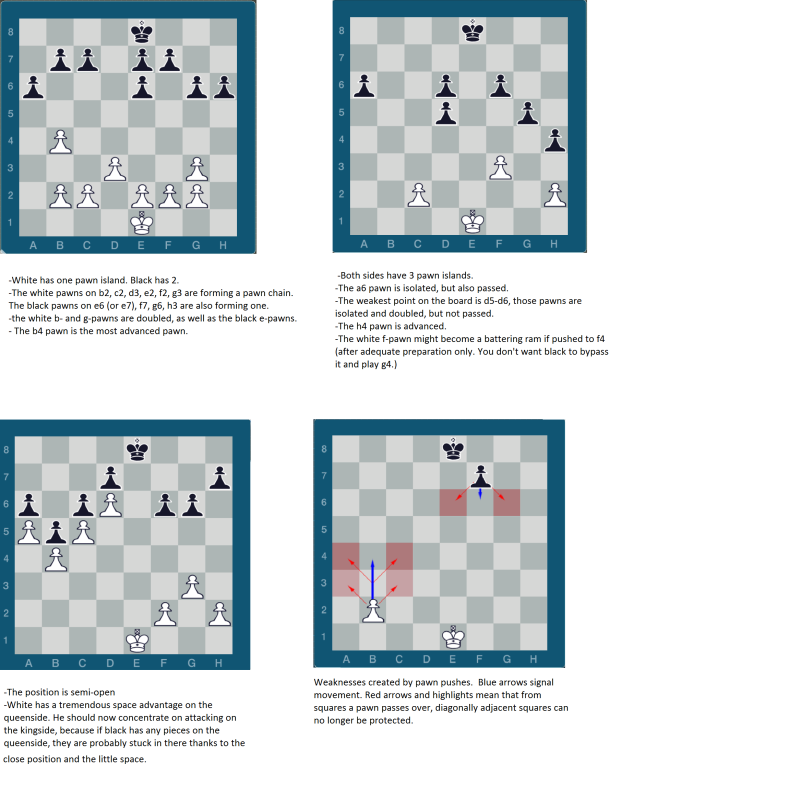


P.S.: Solutions to the puzzles will come soon!
EDIT: Oh, that's a shame. My post got a grey background. Now the pictures look quite awful   Well, i don't think I'll go back and edit them, please forgive me for this Well, i don't think I'll go back and edit them, please forgive me for this 
____________
|
|
keldorn

  
  
Promising
Known Hero
that casts green flames
|
 posted August 30, 2011 10:22 PM
posted August 30, 2011 10:22 PM |
|
|
Here are the solutions to the previous puzzles. Sorry for the random highlighted squares  , will pay more attention next time. , will pay more attention next time.
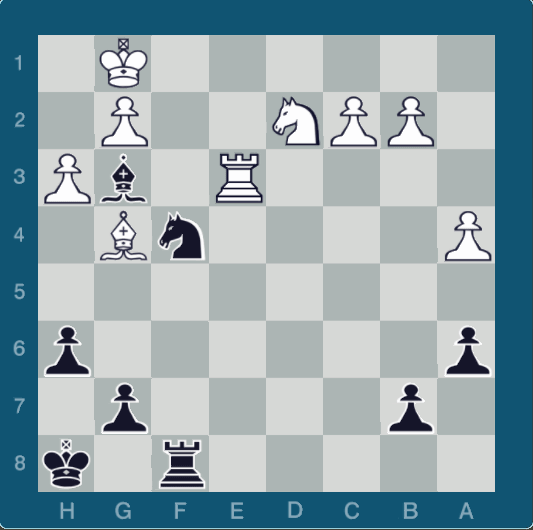

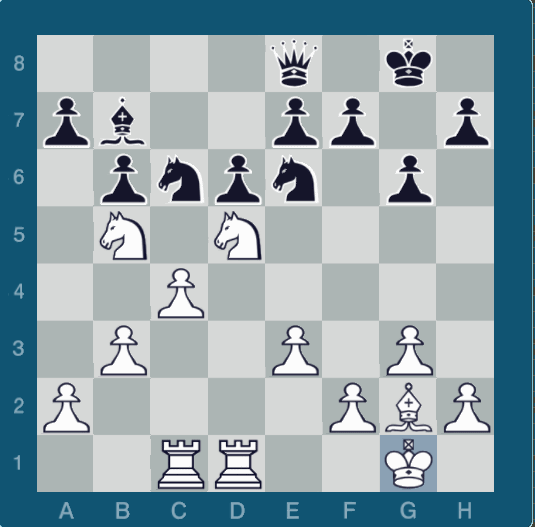
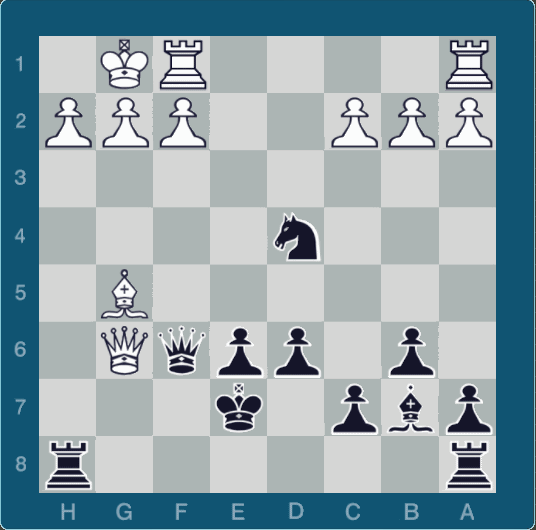
And we can now move on to some endgame puzzles. I hope they will provide you enough task at hands until I finish the first whole-game analysis. Enjoy 
#1. White to play and win.

#2. Black to plan and win.

#3.(!!!) White to play and win.

#4.(!) White to play and win.

These puzzles are tough. Very tough. So let's say that you can think on them for 3 days (time starts when I post). If you'd like to, you can send me HCMs during these days if you think you know the answers. Number one isn't that dificult, but the other three might require community speech. So after the 3 days, we'll forget about HCM and start to share thoughts here. Good luck and have a good time! 
____________
|
|
JoonasTo

   
      
Responsible
Undefeatable Hero
What if Elvin was female?
|
 posted August 30, 2011 10:30 PM
posted August 30, 2011 10:30 PM |
|
|
If you'd always position the chess table the same way or at least note which way the game is played, would be appreciated.
____________
DON'T BE A NOOB, JOIN A.D.V.E.N.T.U.R.E.
|
|
keldorn

  
  
Promising
Known Hero
that casts green flames
|
 posted August 30, 2011 11:25 PM
posted August 30, 2011 11:25 PM |
|
|
Oh, I see your point. I was just unsure about placing the 4 animations together is a good idea. I was afraid of that it would become hard to understand what's going on. You might be right though, it's indeed a bit annoying this way. Maybe I should have made smaller boards and place them next to each other like I did when posting the puzzles? Or perhaps it is simpler not to post the puzzles that way at all, but instead below each other. Yeah, definitely a noteworthy option. Thanks for pointing it out 
____________
|
|
keldorn

  
  
Promising
Known Hero
that casts green flames
|
 posted September 04, 2011 09:37 AM
posted September 04, 2011 09:37 AM |
|
|
OK guys so you may have found out some solutions but some of them are so difficult that it's better to discuss it together. I'll be offline for some days unfortunately but feel free to have a chat with others 
____________
|
|
master_learn

 
     
Legendary Hero
walking to the library
|
 posted August 24, 2012 08:27 PM
posted August 24, 2012 08:27 PM |
|
|
Maybe its time for resurrection of this thread?
I am an average chess player and I would like this to continue(i didnt know it existed 1 year ago).
If other members feel like it,would be good to discuss again!
____________
"I heard the latest HD version disables playing Heroes. Please reconsider."-Salamandre
|
|
keldorn

  
  
Promising
Known Hero
that casts green flames
|
 posted October 04, 2012 08:58 PM
posted October 04, 2012 08:58 PM |
|
|
Oh, I'm so sorry I didn't see your post for more than a month. My bad. In my defence, I must say that I check HC very rarely since I got into university, because I have much less time to play Homm3.
Sure, it would be great to discuss chess again. Here's what our options are:
-Solving puzzles, improving our tactics
-Doing quiz, to check your level of play, covering every field of chess including the opening, the endgame, tactics and positional play, planning, foresight and calculation etc.
-Analysing your or even my games, pointing out winning moves and losing mistakes, sharing the thoughts behind the moves and seeing how they worked out.
-Discuss openings, what are the main idea behind them and how to play them.
-Doing endgame practice with critical positions.
Please, feel free to let me know your favorite option or any own ideas as well.
____________
|
|
master_learn

 
     
Legendary Hero
walking to the library
|
 posted October 04, 2012 09:02 PM
posted October 04, 2012 09:02 PM |
|
|
I think some puzzles and a quiz would be good to go through.
I mean as no much time consuming,yet interesting puzzles and its good also to know how is my current level of play.
____________
"I heard the latest HD version disables playing Heroes. Please reconsider."-Salamandre
|
|
keldorn

  
  
Promising
Known Hero
that casts green flames
|
 posted October 04, 2012 10:37 PM
posted October 04, 2012 10:37 PM |
|
Edited by keldorn at 22:39, 04 Oct 2012.
|
Excellent, I'm definitely going to prepare a quiz, but in the meantime, check these puzzles out:


Have fun and see you soon! 
____________
|
|
keldorn

  
  
Promising
Known Hero
that casts green flames
|
 posted October 05, 2012 09:39 AM
posted October 05, 2012 09:39 AM |
|
|
Ok, a quiz is on its way now. I see you solved the above two puzzles very quickly, so, if you'd like to, check out the previous pack of puzzles on this page (with blue edged chessboards). Those are a bit more tricky endgame puzzles that will hopefully keep you busy until the quiz arrives 
____________
|
|
master_learn

 
     
Legendary Hero
walking to the library
|
 posted October 05, 2012 02:36 PM
posted October 05, 2012 02:36 PM |
|
|
Well,at the moment I took a look at these two and the four above.
My weak side is the end game,so the old second one may take some time.
____________
"I heard the latest HD version disables playing Heroes. Please reconsider."-Salamandre
|
|
keldorn

  
  
Promising
Known Hero
that casts green flames
|
 posted October 07, 2012 07:10 PM
posted October 07, 2012 07:10 PM |
|
|
Ok, the puzzle is half-done, hopefully I'll be able to post it in two days. To pass this time, let's find out the solutions to the 4 endgame puzzles and the two tactical puzzles. You sent me some HCMs so I'll ask a few questions about your selected moves.
The two tactical ones were correct.
The first endgame puzzle was also correct.
The second one is, as you correctly said, a bit tricky so try it again if you'd like, and tell me if you found something. Oh and yes, it's black to move.
The third one is tremendously tricky. You said 1.c7 for white, but how about 1...Rd6+ 2.Kc5 Rc1? Did you calculate this or something else? You said white king must reach c6, but with this sequence, black can prevent this. How does white anticipate this idea?
Finally, you got the 4th one correct as well so you scored 4 out of 6 so far  Let's see the other two shall we? Let's see the other two shall we?
____________
|
|
master_learn

 
     
Legendary Hero
walking to the library
|
 posted October 07, 2012 07:39 PM
posted October 07, 2012 07:39 PM |
|
|
As you explained the threat by Rc1,I sent you how white reacts to prevent that.
I dont have that much free time as I used to have and I may proove a little bit slow,but I wont rush you as well.
I hope other chess players come to visit this thread to make it more alive now!
____________
"I heard the latest HD version disables playing Heroes. Please reconsider."-Salamandre
|
|
keldorn

  
  
Promising
Known Hero
that casts green flames
|
 posted October 07, 2012 11:34 PM
posted October 07, 2012 11:34 PM |
|
|
Maybe we cand send out a few HCMs to the old participants and posters in this thread?
____________
|
|
keldorn

  
  
Promising
Known Hero
that casts green flames
|
 posted October 17, 2012 09:44 PM
posted October 17, 2012 09:44 PM |
|
|
OK, I have to admit that I had tremendously little time last week. However the tasks at hands are done, let's get back to the board 
The quiz is going to arrive this weekend.
Also I have a very good news for you guys: I have just played an incedibly great game with someone online and I'd like to share it with you in form of an analysis. It will include thoughts behind the moves and pointing out mistakes and good moves. Trust me, it is gonna be excellent.
So, brace yourselves, high activity is coming  . I'm counting on you, so feel free to join please . I'm counting on you, so feel free to join please 
____________
|
|
JoonasTo

   
      
Responsible
Undefeatable Hero
What if Elvin was female?
|
 posted October 17, 2012 09:49 PM
posted October 17, 2012 09:49 PM |
|
|
Just to giver you guys a note, I'm still following this thread.
____________
DON'T BE A NOOB, JOIN A.D.V.E.N.T.U.R.E.
|
|
master_learn

 
     
Legendary Hero
walking to the library
|
 posted October 20, 2012 11:40 AM
posted October 20, 2012 11:40 AM |
|
|
I sent HCMs to some of those who posted in this thread and I hope they to enjoy the courses again!
From the first pages of the thread I see TheDeath and Asheera were very active at the time...
____________
"I heard the latest HD version disables playing Heroes. Please reconsider."-Salamandre
|
|
keldorn

  
  
Promising
Known Hero
that casts green flames
|
 posted October 21, 2012 06:12 PM
posted October 21, 2012 06:12 PM |
|
Edited by keldorn at 18:15, 21 Oct 2012.
|
Here we go, the long-desired quiz is finally ready so enjoy  As always, please send me one HCM including all your answers. Good luck and have fun! As always, please send me one HCM including all your answers. Good luck and have fun!
Section 1: Openings
This time I won't be giving you any candidate moves to choose from, you're all on your own, but these ones may be a little bit more easy than the previous ones. Sorry, I forgot to add to the pictures whose move is it, so let me do it here.
#1: position arrived at after 1.e4 e5 2.Nf3 Nc6 3.Bc4 Nf6 4.Ng5. Black to move. (Fried liver attack)
#2: position arrived at after 1.e4 c4 2.d4 d5 3.Nc3 dxe4 4.Nxe4 Bf5 White to move. (Caro-Kann defence, exchange variation)
#3: 1.d4 Nf6 2.c4 g6 3.Nc3 Bg7 4.e4 0-0 5.Nf3 and black is on the move. (King's indian defence)
#4: 1.e4 e6 2.d4 d5 3. Nc3 Bb4 4.e5 c5 and it's White's turn. (French defense, Winawer variation)
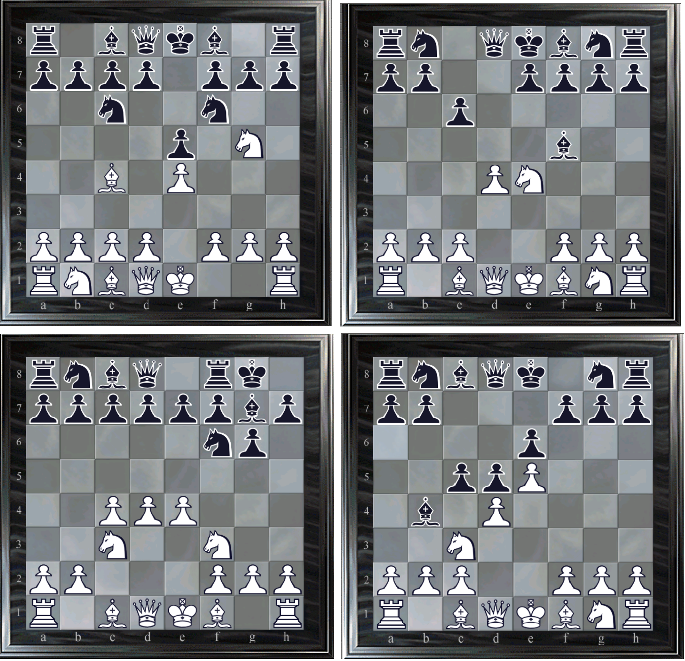
Section 2: Tactics
The side to move is written on the top of each boards. Give the best continuation and the best reply as a sequence of moves, continuing on until where you think the tactic finishes and there's nothing tactical left (the moving side has a winning advantage)
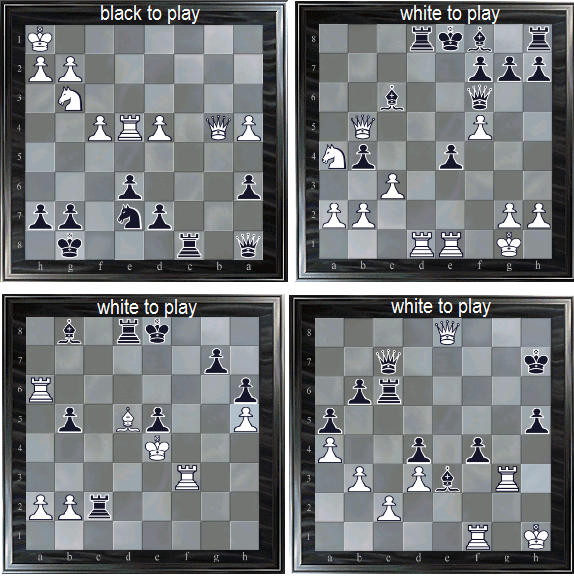
Section 3: Positional play
The side to move is written on top of every board. Give the best move that you think will improve your position the most, plus give the ideas behind your choice. Explain your move in 1-2 sentences. (Note: There's one best move for each puzzle, but depending on your explanation, not-as-good moves will still worth some points if they are well-playable.)

Section 4: Endgames
In all 4 puzzles it's white to move and it's up to you to determine the best continuation. To justify your selected move, give me the "what-if's", in other words the most likely possible continuations.
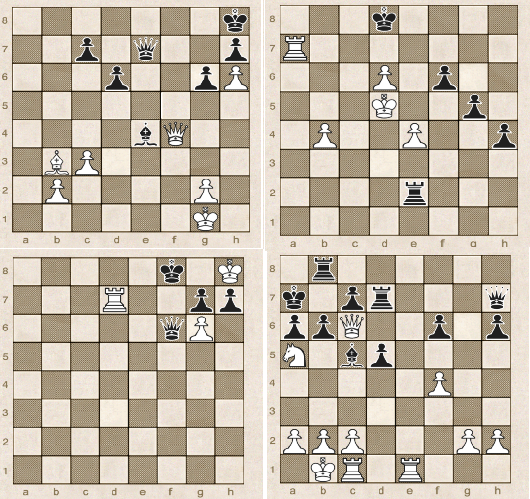
Section five: Extra points
Compose a tactical puzzle that I can't solve. Let me repeat the word compose. Don't send me an already existing puzzle, make one yourself. If I don't manage to solve it, you'll get 3 points. If I do, you still get one point. If the puzzle doesn't work or is erroneous, you won't at all be rewarded anything. You can send me your composition in your HCM the following ways:
- on this link you can set up your position by first clicking on a square on the empty board, and then selecting a piece that you want to be on that square from the line above it. Then you can take a picture with the print screen button, upload the image to for example Photobucket and give the link in your HCM. Don't forget to add who is to play!
-You can write the pieces + their locations in your HCM this way (just an example): White: Ka2, Rd5, e4; Black: Kh7, Qg6 White to move (meaning that white has a king on a2, a rook on d5, a pawn on e4 etc.)
Once again, have fun and a good time solving! 
P.S. Deadline: 28th of October. We'll be doing a game analysis of mine in the meantime. Will be back soon 
____________
|
|
master_learn

 
     
Legendary Hero
walking to the library
|
 posted October 28, 2012 04:38 PM
posted October 28, 2012 04:38 PM |
|
|
Quote:
We'll be doing a game analysis of mine in the meantime. Will be back soon 
The game analysis seem to be postponed for some other time.
Hope that you will have free time again soon to check the answers for the quiz and to give one example of the mentioned analysis.
____________
"I heard the latest HD version disables playing Heroes. Please reconsider."-Salamandre
|
| |
|
|





